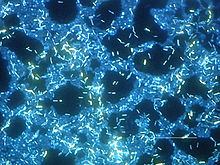Abstract
Pseudomonas aeruginosa is an opportunistic pathogen that causes serious illness, especially in immunocompromised individuals. P. aeruginosa forms biofilms that contribute to growth and persistence in a wide range of environments. Here we investigated the aminopeptidase, P. aeruginosa aminopeptidase (PaAP) from P. aeruginosa, which is highly abundant in the biofilm matrix. PaAP is associated with biofilm development and contributes to nutrient recycling. We confirmed that post-translational processing was required for activation and PaAP is a promiscuous aminopeptidase acting on unstructured regions of peptides and proteins. Crystal structures of wild-type enzymes and variants revealed the mechanism of autoinhibition, whereby the C-terminal propeptide locks the protease-associated domain and the catalytic peptidase domain into a self-inhibited conformation. Inspired by this, we designed a highly potent small cyclic-peptide inhibitor that recapitulates the deleterious phenotype observed with a PaAP deletion variant in biofilm assays and present a path toward targeting secreted proteins in a biofilm context.
Main
Pseudomonas aeruginosa is an environmental bacterium that colonizes a wide range of aquatic and terrestrial habitats. It is a well-known opportunistic human pathogen causing both acute and chronic diseases. Moreover, it is one of the leading causes of chronic infection in cystic fibrosis where its ability to adapt and thrive in different environments makes it incredibly difficult to treat1,2. The survival strategies of P. aeruginosa include its ability to form complex biofilms and secrete numerous virulence factors3,4,5,6. Secreted virulence factors specifically enhance pathogen survival in a host context and, for P. aeruginosa, encompass extracellular polymeric substances, which include the exopolysaccharides alginate, Pel and Psl; outer membrane vesicles (OMV)7,8; siderophores, such as pyoverdine and pyochelin; toxins such as exotoxin A and pyocyanin; and lytic enzymes, such as proteases and nucleases. Many of these secreted factors cause cell and tissue damage, interfere with host defenses and promote bacterial growth and proliferation9.
Secreted proteases are considered major virulence factors of P. aeruginosa. These include an alkaline protease, elastases (LasA and LasB) and a lysin-specific endopeptidase (protease IV, also referred to as LysC)9,10. LasB degrades collagens, causing severe tissue damage11. It also interferes with host defenses by degrading several innate immune components12,13. Alkaline protease degrades many host proteins, including fibronectin and laminin, playing an important role in invasion and tissue necrosis. It is an important protein to escape bacterial defenses by degrading complement proteins and cytokines14. Protease IV is mainly associated with virulence in corneal infections15,16. It is involved in tissue damage and invasion by degrading fibrinogen.
Recently, attention has been directed to exploring other secreted proteases that may contribute to P. aeruginosa success and complement the activity of the endopeptidases described above. The secreted exopeptidase, P. aeruginosa aminopeptidase (PaAP; pepB, PA14_26020), is one of the most abundant proteins in the biofilm matrix17. Interestingly, PaAP is also the major protein associated with P. aeruginosa OMVs. These spherical bilayered phospholipids encapsulate proteins, lipopolysaccharides, and DNA and have been implicated in important biological functions such as virulence and nutrient acquisition7.
PaAP is annotated as an aminopeptidase, which removes amino acids from the N-termini of peptides, with a preference for leucine18. It is linked to biofilm development, where it is suggested to have a role in nutrient recycling, leading to its characterization as a ‘public good’ enzyme (an enzyme that benefits both the producing and nonproducing micro-organisms)19. Its expression is dependent on the stress sigma factor RpoS and is affected by quorum-sensing (QS) systems20,21,22. Moreover, PaAP requires post-translational processing to become an active enzyme. It is secreted through the type II secretion system (also regulated by the QS system) into the extracellular matrix4. Once secreted, PaAP undergoes proteolytic processing by other extracellular matrix proteases, such as truncation of the short C-terminal propeptide region by LysC23. Before our work, a precise molecular role for C-terminal truncation was absent.
Here we investigated the structure and function of PaAP, its catalytic and regulatory mechanism and its importance during biofilm development. We determined the elegant regulatory mechanism whereby the C-terminal propeptide region of PaAP binds in a groove between the protease and protease-associated (PA) domain, blocking access to the active site pocket. Moreover, we provide evidence that the PA domain functions as a regulator of enzyme activity. Finally, aided by structural insights, we rationally designed a specific and potent peptide inhibitor of the peptidase, which impacts late-stage biofilms as well as planktonic growth, where aminopeptidase activity is required. Our work reveals crucial insights into the secreted protease PaAP and provides a new strategy for the development of anti-biofilm peptides targeting extracellular factors.
Results
Structure of PaAP reveals autoinhibition by C-terminus
We solved the structure of PaAP in multiple forms, which revealed an interesting self-inhibitory mechanism involving the PA domain and the propeptide C-terminus (Fig. 1a). The structure of full-length PaAP was solved to 1.4 Å, and traceable between residues 44 to 536 with a 16 amino acid region (QKAQSRSLQMQKSASQ) near the C-terminus, which lacked density. However, the final ten amino acids (IERWGHDFIK) of the C-terminus could be unambiguously traced (Fig. 1b). The structure of PaAP is similar to other unpublished aminopeptidases that have been uploaded onto the Protein Data Bank (PDB: 2EK8 and 6HC6; Supplementary Fig. 1a). PaAP contains an M28 Zn peptidase domain (residues 44–116 and 274–510) and a PA domain (residues 117–273; Fig. 1a). The aminopeptidase domain is composed of an eight-stranded β-sheet surrounded by helices. The smaller mixed α/β PA domain is attached to the peptidase domain via an extended β-strand. There are three disulfide bonds—two in the peptidase domain, toward the N- and C- termini and one in the PA domain…







